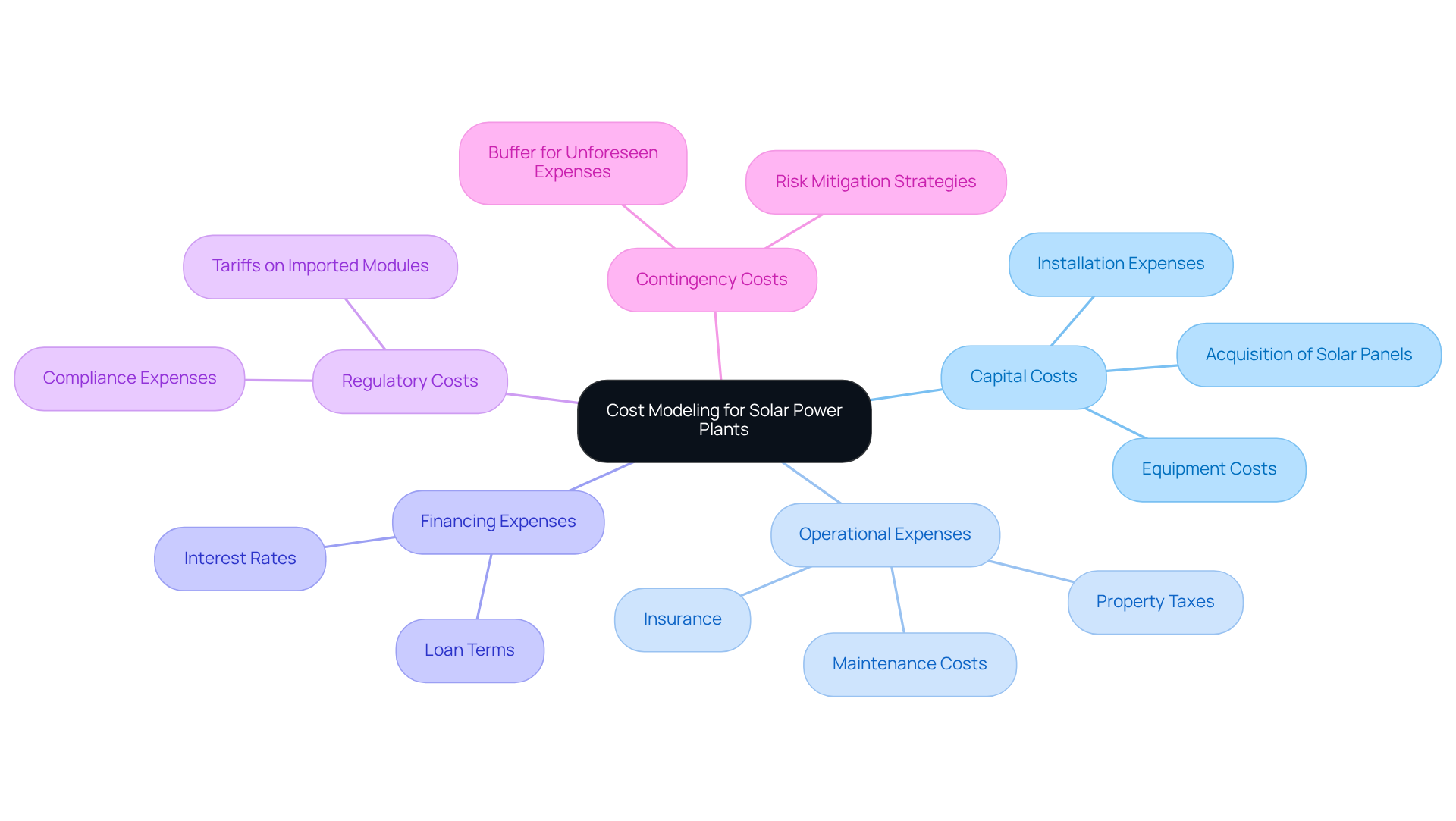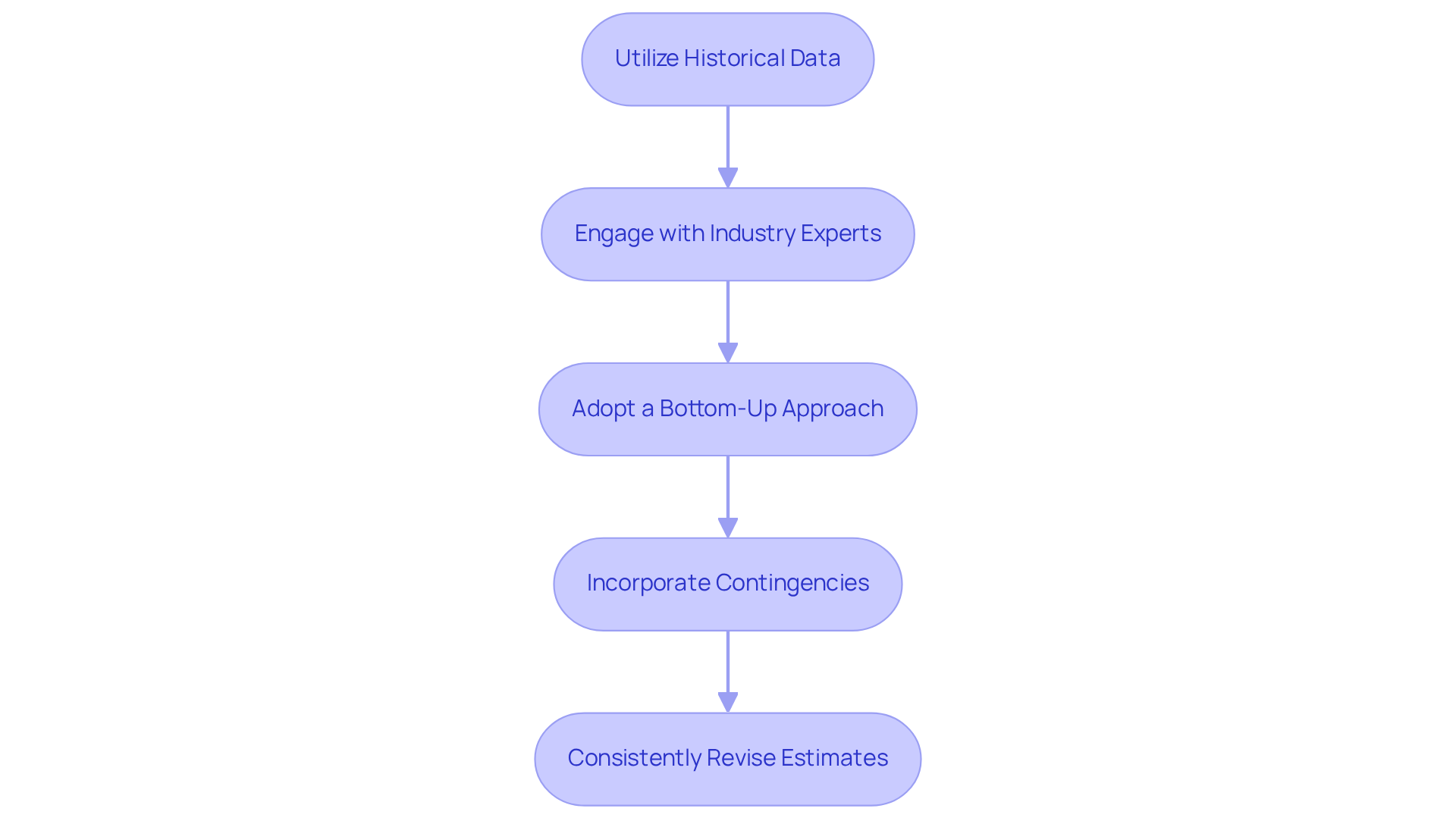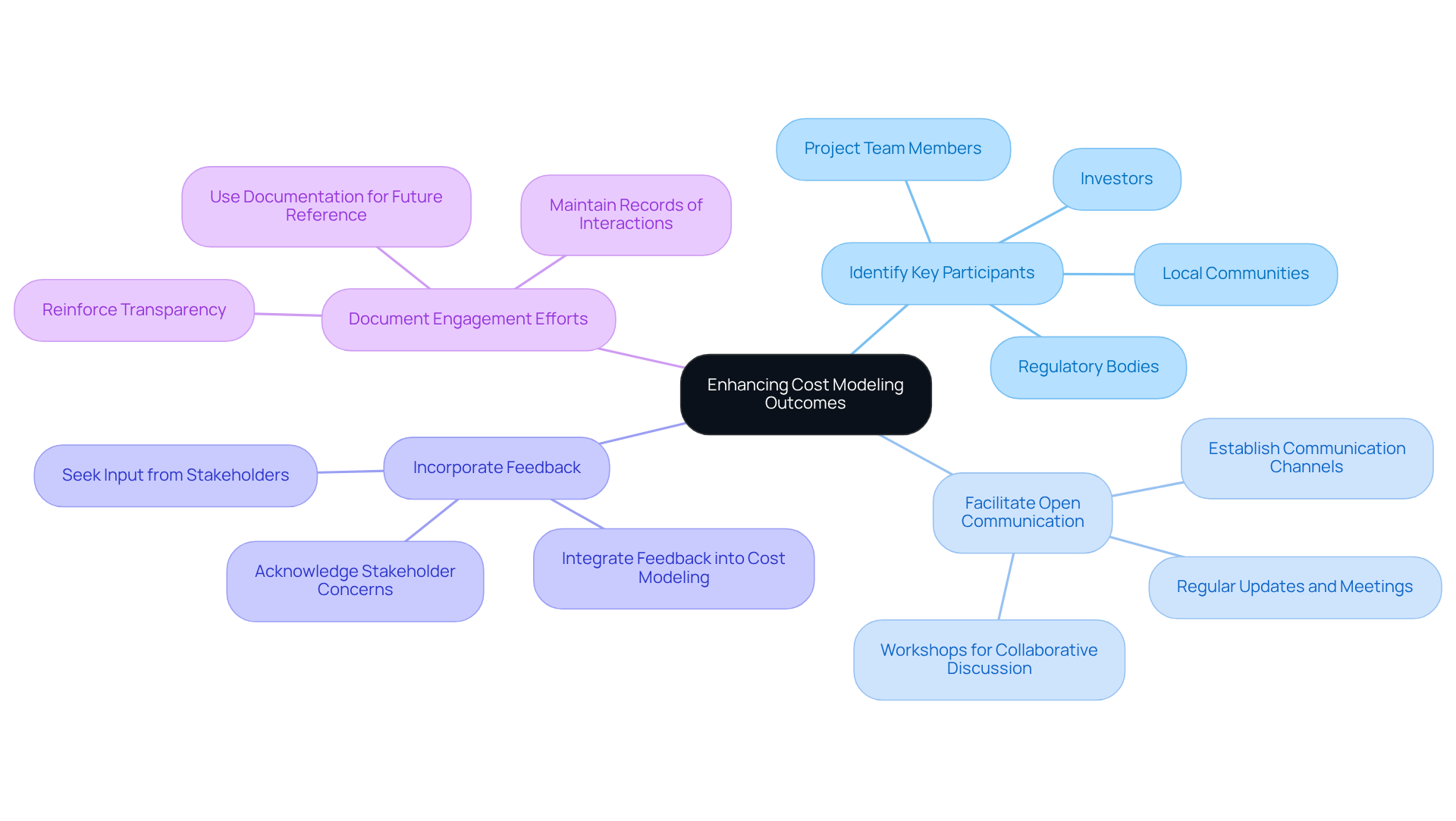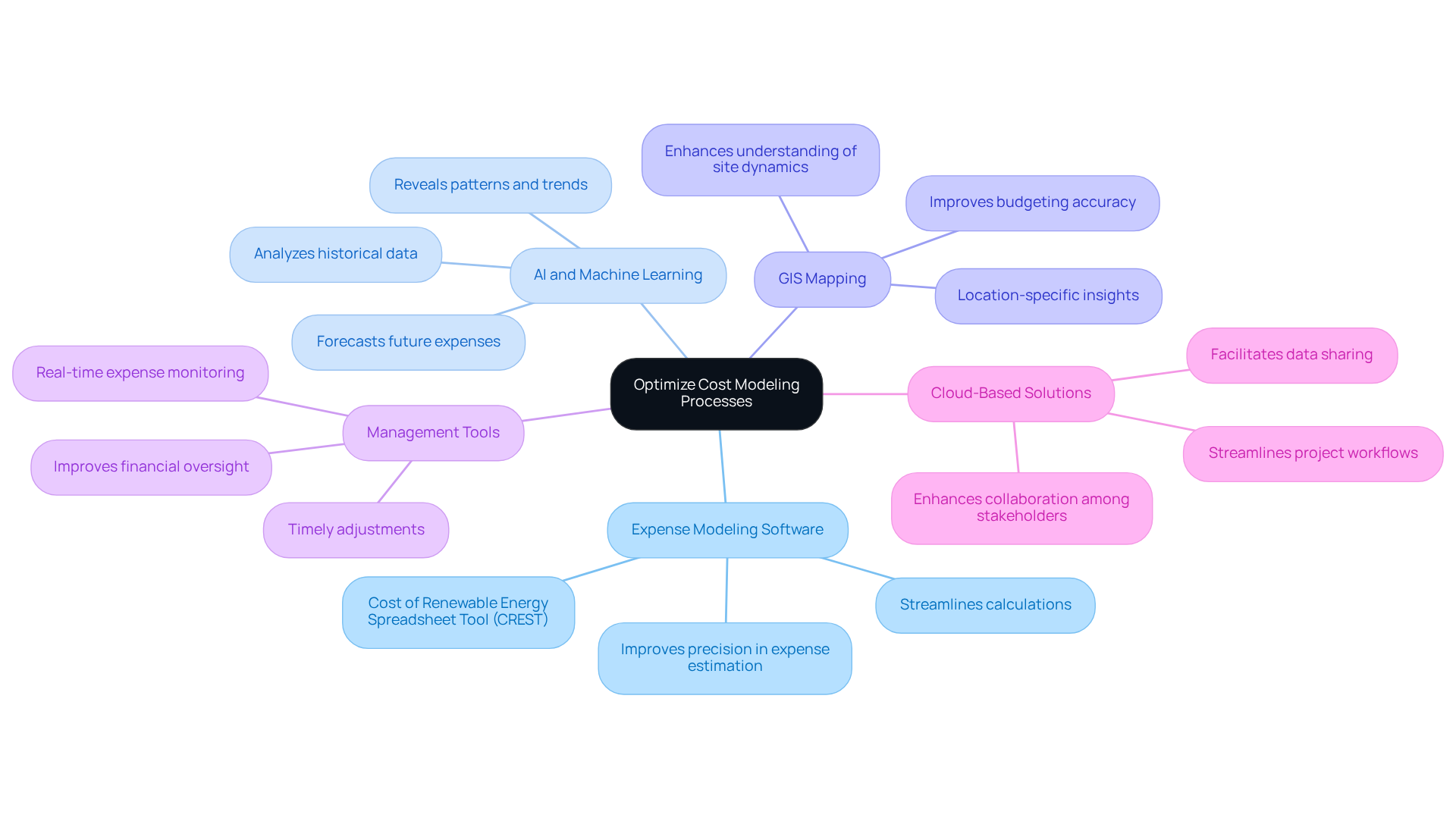Overview
This article delineates four pivotal strategies for effective cost modeling of solar power plants:
- Understanding various cost components
- Implementing precise estimation techniques
- Engaging stakeholders
- Leveraging advanced technology
These strategies are underpinned by insights into capital and operational costs, emphasizing the significance of historical data and expert collaboration. Furthermore, the incorporation of sophisticated tools such as AI and GIS serves to enhance financial planning and ensure project viability within the renewable energy sector.
Introduction
Cost modeling for solar power plants is a pivotal element in securing financial success within a rapidly evolving industry. As the demand for renewable energy escalates, a comprehensive understanding of the intricate components of cost modeling becomes crucial for stakeholders seeking to attract investments and optimize budgets. Yet, with a multitude of variables at play—from capital and operational expenses to regulatory compliance and unforeseen contingencies—how can project developers adeptly navigate this complex landscape? This article explores four key strategies that not only clarify cost estimation processes but also enhance stakeholder engagement and leverage technology, ultimately fostering robust financial planning in solar energy projects.
Understand Key Components of Cost Modeling for Solar Power Plants
Cost modeling for solar power plants includes several essential components that are crucial for financial planning and ensuring project viability.
-
Capital Costs: This category encompasses expenses related to the acquisition and installation of solar panels, inverters, and other necessary equipment. A comprehensive understanding of cost modeling for solar power plants is vital for efficient budgeting and securing financing, as these expenses represent a significant initial investment. As Jim Ollhoff notes, "Solar power is environmentally friendly, available everywhere and versatile."
-
Operational Expenses: Ongoing expenditures, such as maintenance, insurance, and property taxes, must be integrated into the overall financial model. These operational expenses can significantly impact the venture's profitability over time, making precise consideration essential. The anticipated output capacity of solar panels by Qcells USA, expected to reach up to 8.4 GW annually by the end of 2025, underscores the growing importance of effectively managing these expenses.
-
Financing Expenses: The cost of capital, which includes interest rates and loan terms, is a crucial factor in shaping the financial framework of the initiative. Accurate representation of these expenses is necessary for cost modeling for solar power plants to assess the project's viability and long-term financial stability. Ken Salazar emphasizes, "If we are serious about advancing toward energy independence in a cost-effective manner, we should invest in renewable energy."
-
Regulatory Costs: Compliance with local, state, and federal regulations can incur additional expenses. A clear understanding of these requirements is essential for accurate financial estimation and effective cost modeling for solar power plants to avoid unforeseen monetary burdens. The recent solar tariffs, ranging from 50% to over 120% for certain imported modules, highlight the necessity for careful regulatory cost assessment.
-
Contingency Costs: Allocating a buffer for unforeseen expenses is essential to ensure the initiative's financial viability. This contingency planning helps protect against unexpected challenges that may arise during the project's execution. A case analysis on prioritizing early procurement illustrates how effective financial modeling can contribute to success by mitigating risks associated with rising costs.
By thoroughly examining these elements and incorporating insights from industry experts and current data, stakeholders can develop a robust financial model that includes cost modeling for solar power plants, accurately reflecting the economic landscape of renewable energy initiatives. This approach ultimately enhances decision-making and investment strategies.

Implement Effective Strategies for Accurate Cost Estimation
To achieve precise cost estimation for solar power plants, consider implementing the following strategies:
-
Utilize Historical Data: Harness insights from previous projects to inform your pricing estimates. Examining historical data uncovers common costs linked to comparable initiatives, resulting in more dependable forecasts. For instance, photovoltaic energy has been the leading new generating capacity added to the grid each year since 2021, emphasizing the importance of cost modeling for solar power plants in a swiftly expanding sector.
-
Engage with Industry Experts: Collaborate with seasoned professionals who possess hands-on experience in renewable energy project development. Their insights can significantly improve the precision of your expense estimates, which is crucial for cost modeling for solar power plants and providing context for current market conditions. As Ramez Naam emphasizes, solar energy has an advantageous pricing framework due to its initial capital expense and absence of continuous fuel expenses.
-
Adopt a Bottom-Up Approach: Break down expenses into individual elements—such as equipment, labor, and permits—to establish a detailed and transparent financial structure. This method aids in the identification of possible expenditure overruns and enhances budget management by utilizing cost modeling for solar power plants. Avoid typical mistakes like overlooking concealed expenses that may arise during implementation.
-
Incorporate Contingencies: Always allocate contingency funds within your budget to accommodate unforeseen expenses. In cost modeling for solar power plants, a common procedure is to set aside 10-20% of the total projected expenses for contingencies, ensuring financial flexibility.
-
Consistently Revise Estimates: As project parameters change, continuously adjust financial estimates to reflect the latest information. This practice keeps participants informed about the project's financial status and aids in proactive decision-making. Furthermore, citing case studies, such as significant U.S. companies investing in solar and storage, can demonstrate the effectiveness of cost modeling for solar power plants in practical situations.

Engage Stakeholders to Enhance Cost Modeling Outcomes
To enhance cost modeling for solar power plants outcomes through stakeholder engagement, it is crucial to implement effective practices that resonate with key participants.
-
Identify Key Participants: Recognizing essential stakeholders—such as investors, local communities, regulatory bodies, and project team members—is vital. Understanding their interests and concerns lays the groundwork for effective engagement.
-
Facilitate Open Communication: Establishing channels for open dialogue allows stakeholders to share insights and feedback. Regular updates and meetings keep everyone informed and involved, fostering a culture of mutual respect and collaboration. As noted by SolSmart, strong community support is essential for municipalities and counties to achieve their solar energy development goals.
Conducting workshops to collaboratively discuss cost modeling for solar power plants pricing assumptions and methodologies promotes participant involvement. This approach leads to more thorough and precise financial estimates. For instance, case studies on engagement strategies demonstrate that workshops effectively engage a variety of interest groups.
Incorporate feedback by actively seeking and integrating input from relevant parties into the cost modeling for solar power plants process, enhancing accuracy and fostering trust. Acknowledging stakeholders' concerns ensures their commitment. Notably, the solar industry has seen a 167% rise in employment since 2010, highlighting the increasing importance of participant engagement in this sector.
- Document Engagement Efforts: Maintaining detailed records of stakeholder interactions and feedback serves as a valuable reference for future endeavors. This documentation not only addresses potential concerns but also reinforces the significance of transparency in management.

Leverage Technology to Optimize Cost Modeling Processes
To enhance cost modeling processes in solar projects, consider implementing the following strategies:
-
Adopt Expense Modeling Software: Leverage specialized tools such as the Cost of Renewable Energy Spreadsheet Tool (CREST) to streamline calculations and improve precision in expense estimation. Developed through a partnership involving NREL and the U.S. Department of Energy, CREST stands as a reliable resource for assessing project economics.
-
Implement AI and Machine Learning: Harness AI-driven technologies to analyze historical data and forecast future expenses. These advanced tools can reveal patterns and trends that traditional methods may overlook, facilitating more informed decision-making. As noted by Ben Zientara, the solar energy sector has been rapidly expanding in the U.S., with over 160 gigawatts of solar panels installed. This underscores the critical need for precise cost modeling for solar power plants in this growing market.
-
Utilize GIS Mapping: Geographic Information Systems (GIS) provide essential insights into location-specific factors affecting expenses, including land use, environmental considerations, and proximity to existing infrastructure. This technology significantly enhances the understanding of site dynamics, leading to more accurate budgeting.
-
Integrate Management Tools: Employ management software to monitor expenses in real-time, allowing for timely adjustments and improving financial oversight throughout the project lifecycle. This proactive approach ensures that any budget deviations can be swiftly addressed, preserving the initiative's feasibility.
-
Utilize Cloud-Based Solutions: Cloud technology fosters seamless collaboration among stakeholders, enhancing data sharing and communication. This greatly enhances the cost modeling for solar power plants process. By enabling real-time updates and access to information, cloud solutions streamline project workflows and enhance decision-making efficiency.

Conclusion
Effective cost modeling for solar power plants is not just beneficial; it is essential for ensuring project viability and financial success. Understanding key components—capital costs, operational expenses, financing expenses, regulatory costs, and contingency costs—allows stakeholders to develop a comprehensive financial model that accurately reflects the economic landscape of renewable energy initiatives. This strategic approach enhances budgeting and investment strategies, thereby contributing to the overall sustainability of solar projects.
To achieve precise cost estimation, several strategies can be employed:
- Utilizing historical data
- Engaging with industry experts
- Adopting a bottom-up approach
- Incorporating contingencies
- Consistently revising estimates
Furthermore, fostering collaboration and trust through open communication and documentation of feedback is crucial for refining cost modeling outcomes. Leveraging technology—such as expense modeling software, AI, GIS mapping, and cloud-based solutions—optimizes the cost modeling process, leading to better decision-making and project management.
The significance of effective cost modeling in solar power plants cannot be overstated. As the solar industry continues to expand, employing best practices and innovative technologies will be vital for overcoming financial challenges and ensuring the successful implementation of renewable energy projects. Stakeholders are encouraged to embrace these strategies and collaborate actively to drive the future of solar energy forward, paving the way for a more sustainable and economically viable energy landscape.
Frequently Asked Questions
What are the key components of cost modeling for solar power plants?
The key components include capital costs, operational expenses, financing expenses, regulatory costs, and contingency costs.
What do capital costs entail in solar power plant cost modeling?
Capital costs encompass expenses related to the acquisition and installation of solar panels, inverters, and other necessary equipment, representing a significant initial investment.
Why are operational expenses important in cost modeling for solar power plants?
Operational expenses, such as maintenance, insurance, and property taxes, significantly impact the venture's profitability over time, making precise consideration essential for financial modeling.
How do financing expenses affect solar power plant projects?
Financing expenses, including interest rates and loan terms, are crucial for shaping the financial framework of the initiative and assessing the project's viability and long-term financial stability.
What are regulatory costs in the context of solar power plants?
Regulatory costs are incurred from compliance with local, state, and federal regulations, which are essential for accurate financial estimation and avoiding unforeseen monetary burdens.
Why is it important to allocate contingency costs in solar power plant projects?
Allocating contingency costs helps ensure the project's financial viability by providing a buffer for unforeseen expenses that may arise during execution.
How can a thorough examination of these cost components benefit stakeholders?
By examining these elements and incorporating insights from experts, stakeholders can develop a robust financial model that enhances decision-making and investment strategies in renewable energy initiatives.
List of Sources
- Understand Key Components of Cost Modeling for Solar Power Plants
- Trump Solar Tariffs Are Shaping Solar Installer Strategies in 2025 (https://greenlancer.com/post/trump-solar-tariffs)
- Quotes About Solar Power: 50 Picks to Light Up Your Life - Lumify Energy (https://lumifyenergy.com/blog/quotes-about-solar-power)
- The Executive Headlines - Top business magazine & news headlines sources (https://executiveheadlines.com/erp/quotes-on-sustainable-energy)
- 60 Quotes About the Future of Renewable Energy (https://deliberatedirections.com/renewable-energy-quotes)
- Implement Effective Strategies for Accurate Cost Estimation
- Quotes About Solar Power: 50 Picks to Light Up Your Life - Lumify Energy (https://lumifyenergy.com/blog/quotes-about-solar-power)
- Solar Industry Research Data – SEIA (https://seia.org/research-resources/solar-industry-research-data)
- Solar Panel Prices Are Rising Again. Here’s Why, and What May Be Next - Inside Climate News (https://insideclimatenews.org/news/03042025/inside-clean-energy-solar-panel-prices-increase)
- 20 Quotes To Get You Inspired For a Renewable Future - Solstice (https://solstice.us/solstice-blog/20-quotes-for-a-renewable-future)
- Top Ten Quotes about Solar Power (https://harnessoursun.com/top-ten-quotes-about-solar-power)
- Engage Stakeholders to Enhance Cost Modeling Outcomes
- Solar Energy Toolkit: Stakeholder Engagement | SolSmart (https://solsmart.org/resource/stakeholder-engagement)
- 43 Inspiring Project Management Quotes | FounderJar (https://founderjar.com/project-management-quotes)
- 85 quotes about communication in business to motivate teams and leaders (https://textline.com/blog/quotes-about-communication-in-business)
- 50+ Project Management Quotes to Learn From (https://proprofsproject.com/blog/project-management-quotes)
- The Importance of Communication in Project Management (https://instituteprojectmanagement.com/blog/the-crucial-role-of-communication-in-project-management)
- Leverage Technology to Optimize Cost Modeling Processes
- CREST: Cost of Renewable Energy Spreadsheet Tool | Energy Systems Analysis | NREL (https://nrel.gov/analysis/crest)
- 60 Quotes About the Future of Renewable Energy (https://deliberatedirections.com/renewable-energy-quotes)
- Quotes About Solar Power: 50 Picks to Light Up Your Life - Lumify Energy (https://lumifyenergy.com/blog/quotes-about-solar-power)
- 2025 Solar Energy Statistics: Latest Industry Survey Data (https://solarreviews.com/blog/solarreviews-solar-industry-survey-key-statistics)




